| Article ID | Journal | Published Year | Pages | File Type |
|---|---|---|---|---|
| 10547550 | Journal of Analytical and Applied Pyrolysis | 2005 | 6 Pages |
Abstract
In this work, pyrolysis mass spectrometry techniques were applied to investigate the thermal and the structural characteristics of electrochemically prepared BF4â doped poly(3-methylthiophene) (PMTh) and to explore the effect of methyl substitution on thermal and structural characteristics of polythiophene (PTh). It has been determined that thermal degradation of BF4â doped PMTh films occurs in two steps as in the case of polythiophene. The first step was assigned to the loss of the dopant, and the second step to the degradation of the polymer backbone producing segments of various conjugation lengths. Detection of H2S, C3H4, and C2H2 in the final stage of pyrolysis was again associated with a network structure. Significant decrease in the relative intensities of dopant-based products indicated decrease in extent of doping. However, as dopant-based products of PMTh appeared at slightly higher temperatures, a stronger interaction between the dopant and the host polymer PMTh may be proposed. Decomposition of polymer during dedoping pointed out that electrochemical reversibility of the transition between the doped and undoped states is limited for PMTh.
Related Topics
Physical Sciences and Engineering
Chemistry
Analytical Chemistry
Authors
Tuba Gozet, Jale Hacaloglu,
